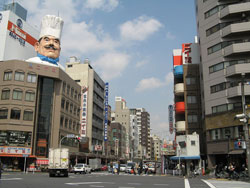
Despite being engrossed in the latest instalment of Candy Crush or busy chatting with their friends on messaging app Line, most manage to weave around cyclists, skateboarders and fellow Tokyoites.
But the growing ranks of these cellphone addicts are turning cities like Tokyo, London, New York and Hong Kong into increasingly hazardous hotspots, where zombified shoppers appear to be part of vast games of human pinball.
"Hey, watch it!" barks a middle-aged salaried man as a hipster typing on his smartphone slams into him during one recent Friday evening crush hour.
"Incidents involving people walking or on bicycles account for 41% of phone-related accidents," Tetsuya Yamamoto, a senior official at Tokyo Fire Department's disaster prevention and safety section, told AFP.
"If people continue walking around looking at their phones, I think we could see more accidents happening."
It goes beyond being an innocuous inconvenience where both people apologise before continuing on their merry way.
Tokyo Fire Department, which runs the ambulance service in the megalopolis, says that in the four years to 2013, 122 people had to be rushed to hospital after accidents caused by pedestrians using cellphones.
As well as the vaguely comedic incidents of businessmen smacking into lamp-posts or tripping over dogs, this total also included a middle-aged man who died after straying onto a railway crossing while looking at his phone.
More than half of Japanese now own a smartphone and the proportion is rising fast, including children who customarily walk to and from school.
Research by Japanese mobile giant NTT Docomo estimates a pedestrian's average field of vision while staring down at a smartphone is just 5% of what our eyes take in normally.
"Children wouldn't be safe in that situation," said Hiroshi Suzuki, manager of corporate social responsibility at the company. "It's dangerous and it's our job to make sure it doesn't actually happen."
The company ran a computer simulation of what could occur in Shibuya if everyone crossing the intersection was looking at their smartphones.
The results, based on a fairly average 1,500 people swarming over the road at any one time, were alarming: 446 collisions, 103 knockdowns and 21 dropped phones. Only around a third reach the other side without incident.
That 82 of the 103 who fell to the ground managed to cling onto their precious phones tells its own story.
Japanese media reported that around half of the 56 bodies recovered from the peak of a volcano after a recent eruption were found clutching mobile phones with photos of the deadly lava and ash on them.
Apparently, they had thought it important to be able to show their social media friends what was happening than to try to save themselves.
Suzuki travels to schools across Japan teaching children how to be responsible with smartphones through the use of cartoons.
"We use the story of the tortoise and the hare," he said. "The hare shoots off tapping away on his smartphone, and then falls down a hole. We want the children to know they could be the hare."
Phone fidgeters dawdling along at snail's pace, forcing cyclists and pram-pushing mums to swerve out of the way have become such an irritant in Tokyo that public notices have started to appear warning offenders to expect "icy stares", appealing to the Japanese sense of social harmony - assuming people look up from their phones in the first place.
Smartphone apps activated by sensors that flash warning signs or display the pavement on the screen have also been developed in response to the problem.
Tokyo is just one of the places struggling to cope with this very 21st century menace.
In China, an amusement park in the south-western megacity of Chongqing has divided a pavement within its grounds into two lanes - one signposted "No mobile phones" and the other "Mobile phone use permitted but all consequences are your responsibility."
Recorded announcements on Hong Kong's subway network warn passengers in Cantonese, Mandarin and English that they are about to step onto an escalator.
While in one city in New York State, there was even a bid to legislate against the use of electronic devices while crossing the road.
NTT Docomo's Suzuki in Tokyo says despite the city's high density and huge population - 35 million in the greater urban area - there's no need yet for people to wear crash helmets when they pop to the shops.
"I don't think we will see the need for that in the near future," he said.
"But our message is that it could happen. We're all potential victims."
Source: AFP, via I-Net Bridge

For more than two decades, I-Net Bridge has been one of South Africa’s preferred electronic providers of innovative solutions, data of the highest calibre, reliable platforms and excellent supporting systems. Our products include workstations, web applications and data feeds packaged with in-depth news and powerful analytical tools empowering clients to make meaningful decisions.
We pride ourselves on our wide variety of in-house skills, encompassing multiple platforms and applications. These skills enable us to not only function as a first class facility, but also design, implement and support all our client needs at a level that confirms I-Net Bridge a leader in its field.
Go to: http://www.inet.co.za